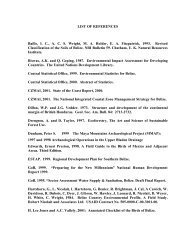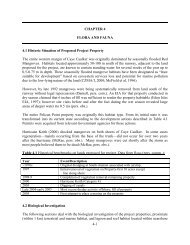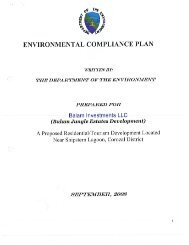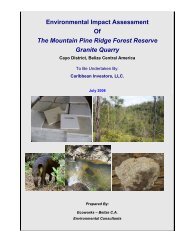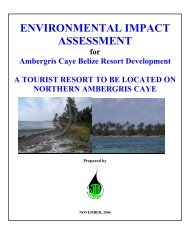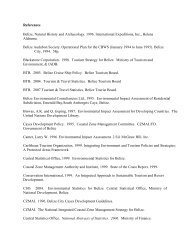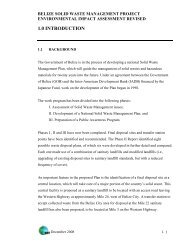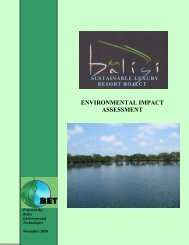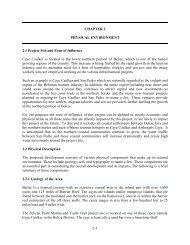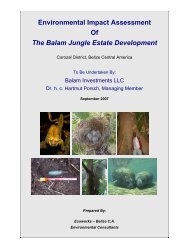ANNEX VIII False Caye Geotechnical Study
ANNEX VIII False Caye Geotechnical Study
ANNEX VIII False Caye Geotechnical Study
Create successful ePaper yourself
Turn your PDF publications into a flip-book with our unique Google optimized e-Paper software.
4.0 DISCUSSION & RECOMMENDATIONS<br />
4.1 General<br />
As can be seen from the soil testing results described in Section 3 above, the soils in the<br />
upper and middle levels on <strong>False</strong> <strong>Caye</strong> have low bearing capacity. Because of the type of<br />
soils encountered (organic silt) and the very low blow counts received, it is not advisable<br />
to place foundations for significant structures to bear on these soils. Not only are the<br />
bearing capacities very low, but also the properties of organic soils are unreliable and<br />
often change over time as matter decays. For roads and pavements, the loading is much<br />
less concentrated than for structures and the tolerance for differential settlements much<br />
larger. Nevertheless, thoughtfully site preparation would be required to ensure that roads<br />
have an acceptable level of performance and durability, as discussed in more detail<br />
below. Attention must be paid to drainage since the site is low and swampy, and finally<br />
any underground conduitry and piping for utilities will have to take into account the<br />
nature of the soils.<br />
4.2 Significant Structures<br />
It is clear from the results of the soil testing that significant structures will require piled<br />
foundations. Additionally, refusal appears to be in excess of the 40-foot maximum for the<br />
rig used by the testing laboratory. SPT blow counts are generally irrelevant for these<br />
depths since shallow-type foundations (i.e. spread footings, strip footings, etc.) cannot be<br />
built economical at these depths. Because of the uncertain depth to refusal, it would be<br />
recommendable to utilize piles that would be stable while being driven over these depths<br />
in poor soils, as well as piles that could be lengthened as necessary during the driving<br />
process. Steel H-piles would likely fit these requirements better than concrete piles, since<br />
sections could be welded on as necessary. Because of the depths to refusal, timber piles<br />
would not be practical for this site.<br />
4.3 Roads and Pavements<br />
As noted, roads and pavements can be built on soils with lower bearing capacity than for<br />
significant structures. Nevertheless, the soils in the upper layers of <strong>False</strong> <strong>Caye</strong> have<br />
bearing capacity that must be considered negligible, and this taken with the soil type<br />
encountered means that undercutting would be recommended before construction of<br />
roads or pavements. Between 5 and 10 feet of poor soil should be removed from the areas<br />
to be constructed upon, and replaced with fill meeting detailed engineering requirements,<br />
properly compacted. The specification for fill should be prepared by a qualified civil<br />
engineer with experience in road works. If this undercutting is not done, there is a high<br />
probability of large settlements, potholing, and generally poor performance in roads and<br />
pavements. Even with the undercutting, particularly if the<br />
6




